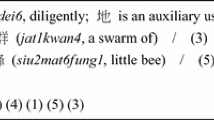Abstract
Based on the Simple View of Reading model, this study examines the relationships among Chinese reading comprehension and its two componential processes, Chinese character reading and listening comprehension, in young learners of Chinese as a second language (CSL) using a longitudinal design. Using relevant measures, a sample of 142 senior primary ethnic minority students in Hong Kong was assessed twice a year. The results of regression analyses showed that character reading and listening comprehension could together account for a significant portion of the variance in reading comprehension at grades 4 and 5 both concurrently and predictively. Subsequently, a trivariate, cross-lagged path model was specified to evaluate the relationships among these variables after controlling for their autoregressive effects. The study identifies statistically significant and unique contributions of character reading and listening comprehension to reading comprehension; further, it finds reciprocal relationships between reading comprehension and its componential processes. Moreover, the two componential processes themselves are significantly related across grades 4 and 5. Apart from supporting the predictive influence of character reading and listening comprehension on reading comprehension, the findings of this study reveal how Chinese language comprehension and literacy development are interrelated in young CSL learners.

Similar content being viewed by others
References
August, D., & Shanahan, T. (2008). Developing reading and writing in second-language learners: Lessons from the report of the National Literacy Panel on language-minority children and youth. New York: Routledge.
Babayiğit, S. (2015). The relations between word reading, oral language, and reading comprehension in children who speak English as a first (L1) and second language (L2): A multigroup structural analysis. Reading and Writing: An Interdisciplinary Journal, 28(4), 527–544. doi:10.1007/s11145-014-9536-x.
Catts, H. W., Herrera, S., Nielsen, D. C., & Bridges, M. S. (2015). Early prediction of reading comprehension within the simple view framework. Reading and Writing: An Interdisciplinary Journal, 28(9), 1407–1425. doi:10.1007/s11145-015-9576-x.
Chinese Language Education Section of the Hong Kong Education Bureau. (2008). Lexical items with English translations for fundamental Chinese learning in Hong Kong schools. Hong Kong: Education Bureau of the Government of the Hong Kong Special Administration Region.
Courville, T., & Thompson, B. (2001). Use of structure coefficients in published multiple regression articles: Is not enough. Educational and Psychological Measurement, 61(2), 229–248. doi:10.1177/0013164401612006.
Curriculum Development Institute of the Hong Kong Education Bureau. (2011). School-based Chinese language assessment tool (applicable to non-Chinese-speaking students). Hong Kong: Government of the Hong Kong Special Administration Region. (in Chinese).
Educational Research Section of the Hong Kong Education Department. (1989a). The third series of the Hong Kong attainment test: Chinese (Grade 1). Hong Kong: Government of the Hong Kong Special Administration Region. (in Chinese).
Educational Research Section of the Hong Kong Education Department. (1989b). The third series of the Hong Kong attainment test: Chinese (Grade 2). Hong Kong: Government of the Hong Kong Special Administration Region. (in Chinese).
Educational Research Section of the Hong Kong Education Department. (1999a). The fifth series of the Hong Kong attainment test: Chinese (Grade 1). Hong Kong: Government of the Hong Kong Special Administration Region. (in Chinese).
Educational Research Section of the Hong Kong Education Department. (1999b). The fifth series of the Hong Kong attainment test: Chinese (Grade 2). Hong Kong: Government of the Hong Kong Special Administration Region. (in Chinese).
Everson, M. E. (1998). Word recognition among learners of Chinese as a foreign language: Investigating the relationship between naming and knowing. Modern Language Journal, 82(2), 194–204. doi:10.1111/j.1540-4781.1998.tb01192.x.
Everson, M. E. (2002). Theoretical developments in reading Chinese and Japanese as foreign languages. In J. H. Sullivan (Ed.), Literacy and the second language learner (pp. 1–16). Connecticut: Information Age Publishing.
Florit, E., & Cain, K. (2011). The simple view of reading: Is it valid for different types of alphabetic orthographies? Educational Psychology Review, 23(4), 553–576. doi:10.1007/s10648-011-9175-6.
Foorman, B., Herrera, S., Petscher, Y., Mitchell, A., & Truckenmiller, A. (2015). The structure of oral language and reading and their relation to comprehension in kindergarten through grade 2. Reading and Writing: An Interdisciplinary Journal, 28(5), 655–681. doi:10.1007/s11145-015-9544-5.
Geva, E., & Farnia, F. (2012). Developmental changes in the nature of language proficiency and reading fluency paint a more complex view of reading comprehension in ELL and EL1. Reading and Writing: An Interdisciplinary Journal, 25(8), 1819–1845. doi:10.1007/s11145-011-9333-8.
Gottardo, A., & Mueller, J. (2009). Are first- and second-language factors related in predicting second-language reading comprehension? A study of Spanish- speaking children acquiring English as a second language from first to second grade. Journal of Educational Psychology, 101(2), 330–344. doi:10.1037/a0014320.
Gough, P. B., Hoover, W. A., & Peterson, C. L. (1996). Some observations on a simple view of reading. In C. Cornoldi & J. Oakhill (Eds.), Reading comprehension difficulties: Processes and intervention (pp. 1–14). New Jersey: Lawrence Erlbaum Associates.
Gough, P. B., & Tunmer, W. E. (1986). Decoding, reading, and reading disability. Remedial and Special Education, 7(1), 6–10.
Gustafson, S., Samuelsson, C., Johansson, E., & Wallmann, J. (2013). How simple is the simple view of reading? Scandinavian Journal of Educational Research, 57(3), 292–308. doi:10.1080/00313831.2012.656279.
Hoover, W. A., & Gough, P. B. (1990). The simple view of reading. Reading and Writing: An Interdisciplinary Journal, 2(2), 127–160.
Jeon, E. H., & Yamashita, J. (2014). L2 reading comprehension and its correlates: A meta-analysis. Language Learning, 64(1), 160–212. doi:10.1111/lang.12034.
Joshi, R. M., Ji, X., Breznitz, Z., Amiel, M., & Yulia, A. (2015). Validation of the simple view of reading in Hebrew—A Semitic language. Scientific Studies of Reading, 19(3), 243–252. doi:10.1080/10888438.2015.1010117.
Joshi, R. M., Tao, S., Aaron, P. G., & Quiroz, B. (2012). Cognitive component of componential model of reading applied to different orthographies. Journal of Learning Disabilities, 45(5), 480–486. doi:10.1177/0022219411432690.
Kang, J. S. (1993). Analysis of semantics of semantic-phonetics compound characters in modern Chinese. In Y. Chen (Ed.), Information analysis of usage of characters in modern Chinese (pp. 71–83). Shanghai: Shanghai Education Publisher. (in Chinese).
Kendeou, P., Papadopoulos, T. C., & Kotzapoulou, M. (2013). Evidence for the early emergence of the simple view of reading in a transparent orthography. Reading and Writing: An Interdisciplinary Journal, 26(2), 189–204. doi:10.1007/s11145-012-9361-z.
Kershaw, S., & Schatschneider, C. (2012). A latent variable approach to the simple view of reading. Reading and Writing: An Interdisciplinary Journal, 25(2), 433–464. doi:10.1007/s11145-010-9278-3.
Li, Y., & Kang, J. S. (1993). Analysis of phonetics of semantic-phonetics compound characters in modern Chinese. In Y. Chen (Ed.), Information analysis of usage of characters in modern Chinese (pp. 84–98). Shanghai: Shanghai Education Publisher. (in Chinese).
Mancilla-Martinez, J., Kieffer, M. J., Biancarosa, G., Christodoulou, J. A., & Snow, C. E. (2011). Investigating English reading comprehension growth in adolescent language minority learners: Some insights from the simple view. Reading and Writing: An Interdisciplinary Journal, 24(3), 339–354. doi:10.1007/s11145-009-9215-5.
Melby-Lervåg, M., & Lervåg, A. (2014). Reading comprehension and its underlying components in second-language learners: A meta-analysis of studies comparing first- and second-language learners. Psychological Bulletin, 140(2), 409–433. doi:10.1037/a0033890.
Nathans, L. L., Oswald, F. L., & Nimon, K. (2012). Interpreting multiple linear regression: a guidebook of variable importance. Practical Assessment, Research & Evaluation, 17(9), 1–19. Available at: http://pareonline.net/getvn.asp?v=17&n=9.
Nimon, K. (2010). Regression commonality analysis: Demonstration of an SPSS solution. Multiple Linear Regression Viewpoints, 36(1), 10–17. Available at: http://www.academia.edu/1046301/Regression_Commonality_Analysis_Demonstration_of_an_SPSS_Solution.
Ouellette, G., & Beers, A. (2010). A not- so-simple view of reading: How oral vocabulary and visual-word recognition complicate the story. Reading and Writing: An Interdisciplinary Journal, 23(2), 189–208. doi:10.1007/s11145-008-9159-1.
Pan, H. R., & Kang, B. W. (Eds.). (2003). A study of the Chinese characters recommended for the subject of Chinese language in primary school. Hong Kong: Hong Kong Baptist University Language Centre.
Shen, H. H. (2005). An investigation of Chinese- character learning strategies among non-native speakers of Chinese. System An International Journal of Educational Technology and Applied Linguistics, 33(1), 49–68. doi:10.1016/j.system.2004.11.001.
Shen, H. H., & Ke, C. (2007). Radical awareness and word acquisition among nonnative learners of Chinese. Modern Language Journal, 91(1), 97–111. doi:10.1111/j.1540-4781.2007.00511.x.
Su, P. C. (2001). Modern Chinese orthography. Beijing: Peking University Press. (in Chinese).
Tilstra, J., Mcmaster, K., Van Den Broek, P., Kendeou, P., & Rapp, D. (2009). Simple but complex: Components of the simple view of reading across grade levels. Journal of Research in Reading, 32(4), 383–401. doi:10.1111/j.1467-9817.2009.01401.x.
Tobia, V., & Bonifacci, P. (2015). The simple view of reading in a transparent orthography: The stronger role of oral comprehension. Reading and Writing: An Interdisciplinary Journal, 28(7), 939–957. doi:10.1007/s11145-015-9556-1.
Tong, X., & Yip, J. (2015). Cracking the Chinese character: Radical sensitivity in learners of Chinese as a foreign language and its relationship to Chinese word reading. Reading and Writing: An Interdisciplinary Journal, 28(2), 159–181. doi:10.1007/s11145-014-9519-y.
Tunmer, W., & Chapman, J. (2012). The simple view of reading redux: Vocabulary knowledge and the independent components hypothesis. Journal of Learning Disabilities (Austin), 45(5), 453–466. doi:10.1177/0022219411432685.
Verhoeven, L., & Van Leeuwe, J. (2012). The simple view of second language reading throughout the primary grades. Reading and Writing: An Interdisciplinary Journal, 25(8), 1805–1818. doi:10.1007/s11145-011-9346-3.
Wagner, R. K., Herrera, S. K., Spencer, M., & Quinn, J. M. (2015). Reconsidering the simple view of reading in an intriguing case of equivalent models: Commentary on Tunmer and Chapman (2012). Journal of Learning Disabilities, 48(2), 115–119. doi:10.1177/0022219414544544.
Wang, M., Liu, Y., & Perfetti, C. A. (2004). The implicit and explicit learning of orthographic structure and function of a new writing system. Scientific Studies of Reading, 8(4), 357–379. doi:10.1207/s1532799xssr0804_3.
Wang, M., Perfetti, C. A., & Liu, Y. (2003). Alphabetic readers quickly acquire orthographic structure in learning to read Chinese. Scientific Studies of Reading, 7(2), 183–208. doi:10.1207/S1532799XSSR0702_4.
Williams, C. (2013). Emerging development of semantic and phonological routes to character decoding in Chinese as a foreign language learners. Reading and Writing: An Interdisciplinary Journal, 26(2), 293–315. doi:10.1007/s11145-012-9368-5.
Xing, J. Z. (2006). Teaching and learning Chinese as a foreign language: A pedagogical grammar. Hong Kong: Hong Kong University Press.
Yeung, P.-S., Ho, C. S.-H., Chan, D. W.-O., Chung, K. K.-H., & Wong, Y.-K. (2013). A model of reading comprehension in Chinese elementary school children. Learning and Individual Differences, 25, 55–66. doi:10.1016/j.lindif.2013.03.004.
Yeung, P., Ho, C. S., Chik, P. P., Lo, L., Luan, H., Chan, D. W., et al. (2011). Reading and spelling Chinese among beginning readers: What skills make a difference? Scientific Studies of Reading, 15(4), 285–313. doi:10.1080/10888438.2010.482149.
Zhang, T. R., Chen, L. H., & Li, W. M. (2000). Contemporary Chinese character reading and writing. Chengdu: Sichuan Education Publisher. (in Chinese).
Zhang, J., McBride-Chang, C., Tong, X., Wong, A. M., Shu, H., & Fong, C. Y. (2012). Reading with meaning: The contributions of meaning-related variables at the word and subword levels to early Chinese reading comprehension. Reading and Writing: An Interdisciplinary Journal, 25(9), 2183–2203. doi:10.1007/s11145-011-9353-4.
Zhang, J., McBride-Chang, C., Wong, A., Tardif, T., Shu, H., & Zhang, Y. (2014). Longitudinal correlates of reading comprehension difficulties in Chinese children. Reading and Writing: An Interdisciplinary Journal, 27(3), 481–501. doi:10.1007/s11145-013-9453-4.
Author information
Authors and Affiliations
Corresponding author
Appendix
Appendix
The test items of the Chinese character recognition test
Chinese character reading test (1)
-
1.
The 50 single-character items are as follows:
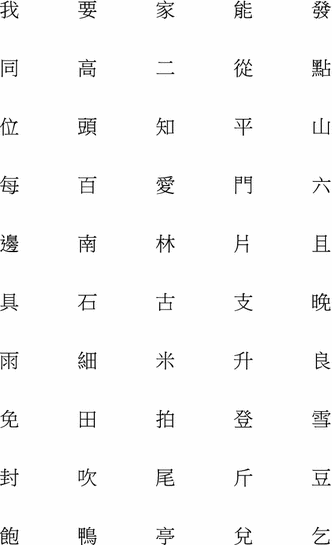
-
2.
The 25 two-character word items are as follows:
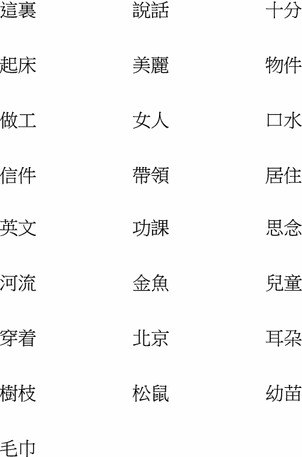
Chinese character reading test (2)
-
1.
The 50 single-character items are as follows:
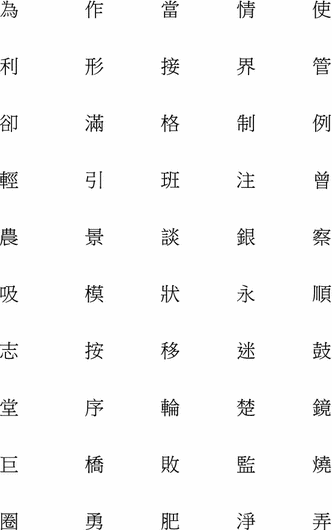
-
2.
The 25 two-character word items are as follows:
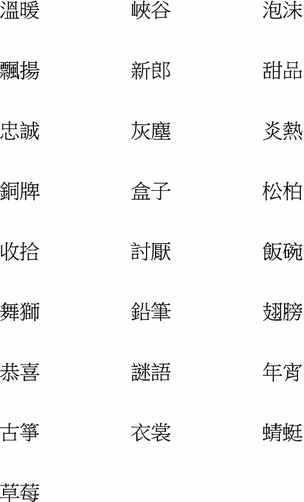
Rights and permissions
About this article
Cite this article
Wong, Y.K. Relationships between reading comprehension and its components in young Chinese-as-a-second-language learners. Read Writ 30, 969–988 (2017). https://doi.org/10.1007/s11145-016-9708-y
Published:
Issue Date:
DOI: https://doi.org/10.1007/s11145-016-9708-y


